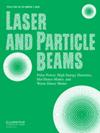电子轰击在慢波结构中的破坏效应分析
IF 1.9
4区 物理与天体物理
Q4 PHYSICS, APPLIED
引用次数: 1
摘要
射频击穿会导致脉冲缩短,严重降低相对论性倒向波振荡器的稳定性和可靠性。本文通过粒子池(PIC)模拟、数值计算和实验验证,讨论了在慢波结构(SWSs)中引起击穿痕迹的电子能量范围。PIC模拟和数值计算结果表明,大多数场致电子在加速后轰击SWS表面的能量小于120 keV。此外,还分析了SWSs中击穿痕迹的微观形貌以及被不同能级电子直接轰击的见证目标。扫描电子显微镜(SEM)显示,击穿痕迹具有波纹状形态,范围广,深度浅。在波纹状地貌附近出现了大量的陨石坑。这些外观非常类似于由低能电子(约160 keV)直接影响的破坏性痕迹。因此,证实了击穿痕迹是低能电子轰击的结果。因此,进一步完善了场发射电子冲击rbwo结构表面的击穿机制。本文章由计算机程序翻译,如有差异,请以英文原文为准。
Analysis of Destructive Effects with Electron Bombardment in Slow-Wave Structures
Radio frequency (RF) breakdown can result in pulse shortening and seriously degrade the stability and reliability of relativistic backward wave oscillators (RBWOs). This paper discusses the energy range of electrons causing breakdown traces in slow-wave structures (SWSs) through particle-in-cell (PIC) simulation, numerical calculation, and experimental verification. The PIC simulation and numerical calculation results reveal that the energy of the majority of the field-induced electrons bombarding the SWS surfaces after being accelerated is less than 120 keV. Furthermore, the micro appearances of the breakdown traces in SWSs and the witness targets bombarded directly by electrons of various energy levels have been analyzed. Scanning electron microscope (SEM) shows that the breakdown traces are featured with corrugated morphologies with a wide range and a shallow depth. A mass of craters emerge in the vicinity of the corrugated morphologies. These appearances are quite similar to destructive traces impacted directly by low-energy electrons (around 160 keV). Thus, it is confirmed that the breakdown traces result from the bombardment of low-energy electrons. Therefore, the breakdown mechanism of field-emitted electrons impacting on the structure surfaces in RBWOs has been further improved.
求助全文
通过发布文献求助,成功后即可免费获取论文全文。
去求助
来源期刊

Laser and Particle Beams
PHYSICS, APPLIED-
CiteScore
1.90
自引率
11.10%
发文量
25
审稿时长
1 months
期刊介绍:
Laser and Particle Beams is an international journal which deals with basic physics issues of intense laser and particle beams, and the interaction of these beams with matter. Research on pulse power technology associated with beam generation is also of strong interest. Subjects covered include the physics of high energy densities; non-LTE phenomena; hot dense matter and related atomic, plasma and hydrodynamic physics and astrophysics; intense sources of coherent radiation; high current particle accelerators; beam-wave interaction; and pulsed power technology.
 求助内容:
求助内容: 应助结果提醒方式:
应助结果提醒方式:


